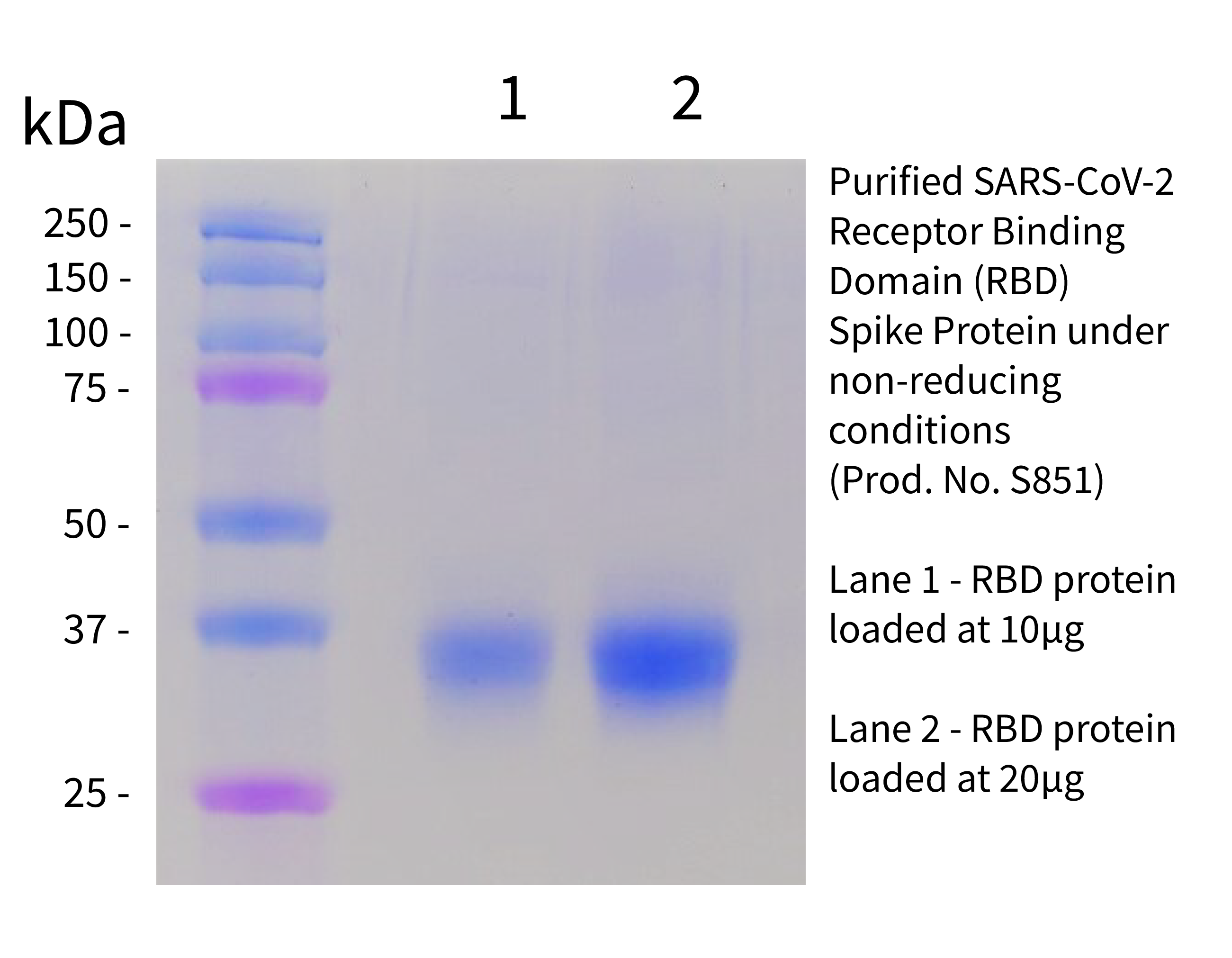Recombinant SARS-CoV-2, RBD Protein
Recombinant SARS-CoV-2, RBD Protein
Product No.: S851
- -
- -
Alternate Names Spike Protein, SARS-CoV-2 Spike Protein, S1 Protein, S1 Subunit, S Protein, Receptor Binding Domain, RBD Product Type Recombinant Protein Expression Host HEK-293 Cells Species SARS-CoV-2 ⋅ Virus Applications ELISA |
Data
- -
- -
BackgroundSevere acute respiratory syndrome coronavirus 2 (SARS-CoV-2), the causative agent of coronavirus disease 2019 (COVID-19), is an enveloped, single-stranded, positive-sense RNA virus that belongs to the Coronaviridae family 1. The SARS-CoV-2 genome, which shares 79.6% identity with SARS-CoV, encodes four essential structural proteins: the spike (S), envelope (E), membrane (M), and nucleocapsid protein (N) 2. The S protein is a transmembrane, homotrimeric, class I fusion glycoprotein that mediates viral attachment, fusion, and entry into host cells 3. Each ~180 kDa monomer contains two functional subunits, S1 (~700 a.a) and S2 (~600 a.a), that mediate viral attachment and membrane fusion, respectively. S1 contains two major domains, the N-terminal (NTD) and C-terminal domains (CTD). The CTD contains the receptor-binding domain (RBD), which binds to the angiotensin-converting enzyme 2 (ACE2) receptor on host cells 3-5. Although both SARS-CoV and SARS-CoV-2 bind the ACE2 receptor, the RBDs only share ~73% amino acid identity, and the SARS-CoV-2 RBD binds with a higher affinity compared to SARS-CoV 3, 6. The RBD is dynamic and undergoes hinge-like conformational changes, referred to as the “down” or “up” conformations, which hide or expose the receptor-binding motifs, respectively 7. Following receptor binding, S1 destabilizes, and TMPRSS2 cleaves S2, which undergoes a pre- to post-fusion conformation transition, allowing for membrane fusion 8, 9. Polyclonal RBD-specific antibodies can block ACE2 binding 10, 11, and anti-RBD neutralizing antibodies are present in the sera of convalescent COVID19 patients 12, identifying the RBD as an attractive candidate for vaccines and therapeutics. In addition, the RBD is poorly conserved, making it a promising antigen for diagnostic tests 13 14. Serologic tests for the RBD are highly sensitive and specific for detecting SARS-CoV-2 antibodies in COVID19 patients 13 15. Furthermore, the levels of anti-RBD antibodies correlated with SARS-CoV-2 neutralizing antibodies, suggesting the RBD could be used to predict an individual's risk of disease 13. Protein DetailsFormat Purified No Carrier Protein Purity >95% by SDS Page Product Concentration 0.5 mg/ml Endotoxin Level <0.10 EU per 1 μg of the protein by the LAL method Protein Accession No. Amino Acid Sequence RVQPTESIVRFPNITNLCPFGEVFNATRFASVYAWNRKRISNCVADYSVLYNSASFSTFK
CYGVSPTKLNDLCFTNVYADSFVIRGDEVRQIAPGQTGKIADYNYKLPDDFTGCVIAWN
SNNLDSKVGGNYNYLYRLFRKSNLKPFERDISTEIYQAGSTPCNGVEGFNCYFPLQSYGF
QPTNGVGYQPYRVVVLSFELLHAPATVCGPKKSTNLVKNKCVNFNFNGLTGTGVLTESN
KKFLPFQQFGRDIADTTDAVRDPQTLEILDITPCS State of Matter Sterile Liquid Predicted Molecular Mass The predicted molecular mass is ~33 kDa. Predicted Molecular Mass ~33 kDa Formulation This recombinant protein is aseptically packaged and formulated in 0.01 M phosphate buffered saline (PBS) pH 7.2 - 7.4, 150 mM NaCl with no carrier protein, potassium, calcium or preservatives added. Due to inherent biochemical properties of proteins, certain products may be prone to precipitation over time. Precipitation may be removed by aseptic centrifugation and/or filtration. Storage and Stability This recombinant protein may be stored as received at 2-8°C for up to one month. For longer term storage, aseptically aliquot in working volumes without diluting and store at -80°C. Avoid Repeated Freeze Thaw Cycles. Country of Origin USA Shipping Next Day Ice Pack NCBI Gene Bank Applications and Recommended Usage ? (Quality Tested by Leinco) ELISA References & Citations1. Zhou, P., Yang, X., Wang, X. et al. Nature 579, 270–273. 2020. 2. Wu, F., Zhao, S., Yu, B. et al. Nature 579, 265–269. 2020. 3. Wrapp D, Wang N, Corbett KS, et al. bioRxiv. 2020.02.11.944462. 2020. 4. Walls AC, Park YJ, Tortorici MA, Wall A, McGuire AT, Veesler D. Cell. 181(2):281-292.e6. 2020. 5. Li W, Zhang C, Sui J, et al. EMBO J. 24(8):1634-1643. 2005. 6. Shang, J., Ye, G., Shi, K. et al. Nature 581, 221–224. 2020. 7. Gui M, Song W, Zhou H, et al. Cell Res. 27(1):119-129. 2017. 8. Walls AC, Tortorici MA, Snijder J, et al. Proc Natl Acad Sci U S A. 114(42):11157-11162. 2017. 9. Hoffmann M, Kleine-Weber H, Schroeder S, et al. Cell. 181(2):271-280.e8. 2020. 10. Huo J, Zhao Y, Ren J, et al. Cell Host Microbe. S1931-3128(20)30351-6. 2020. 11. Tai, W., He, L., Zhang, X. et al. Cell Mol Immunol 17, 613–620. 2020. 12. Cao Y, Su B, Guo X, et al. Cell. 182(1):73-84.e16. 2020. 13. Premkumar L, Segovia-Chumbez B, Jadi R, et al. medRxiv; 2020. 14. Quinlan BD, Mou H, Zhang L, et al. bioRxiv; 2020. 15. Olba NM, Muller MA, Li W, et al. medRxiv; 2020. Technical ProtocolsCertificate of AnalysisIMPORTANT Use lot specific datasheet for all technical information pertaining to this recombinant protein. |
Related Products
- -
- -
Prod No. | Description |
|---|---|
S151 | |
S251 | |
S351 | |
S451 | |
S951 | |
S952 |



